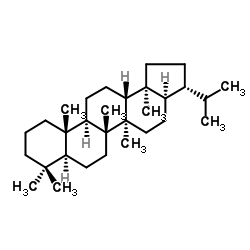17α(H),21β(H)-藿烷

17α(H),21β(H)-藿烷结构式

|
常用名 | 17α(H),21β(H)-藿烷 | 英文名 | 17a-Hopane |
|---|---|---|---|---|
| CAS号 | 13849-96-2 | 分子量 | 412.734 | |
| 密度 | 0.9±0.1 g/cm3 | 沸点 | 457.4±12.0 °C at 760 mmHg | |
| 分子式 | C30H52 | 熔点 | N/A | |
| MSDS | N/A | 闪点 | 221.8±13.1 °C | |
| 符号 |




GHS02, GHS07, GHS08, GHS09 |
信号词 | Danger |
|
Hymenobacter roseus sp. nov., isolated from sand.
Int. J. Syst. Evol. Microbiol. 64(Pt 12) , 4129-33, (2014) Strain JC245(T) was isolated from a sand sample, and appeared as dark pink colonies on agar plates with cells staining Gram-negative. Catalase and oxidase activities were positive. Casein was hydrolysed while chitin, gelatin and starch were not. Major (>5 %) ... |
|
|
Lanostane and hopane triterpenes from the entomopathogenic fungus Hypocrella sp. BCC 14524.
J. Nat. Prod. 74 , 2143-50, (2011) Seven new lanostane-type triterpenes, hypocrellols A-G (1-7), and six new hopane-type triterpenes, 7β,15α-dihydroxy-22(29)-hopene (8), 3β,7β-dihydroxy-22(29)-hopene (9), 3β-acetoxy-15α-hydroxy-22(29)-hopene (10), 3β,7β,15α,22-tetrahydroxyhopane (11), 3β-aceto... |
|
|
Bioactive compounds from the scale insect pathogenic fungus Conoideocrella tenuis BCC 18627.
J. Nat. Prod. 74 , 782-9, (2011) A new cyclohexadepsipeptide, conoideocrellide A (1), its linear derivatives, conoideocrellides B-D (2-4), three new hopane triterpenoids (5-7), two new bioxanthracenes (9 and 10), and a new isocoumarin glycoside (13) were isolated from the scale insect pathog... |
|
|
Sphingopyxis contaminans sp. nov., isolated from a contaminated Petri dish.
Int. J. Syst. Evol. Microbiol. 64(Pt 7) , 2238-43, (2014) Strain JC216(T) was isolated from a contaminated Petri dish. Colonies were of pale yellow colour and cells were Gram-stain-negative, oxidase-positive and catalase-positive. Chitin, starch and gelatin were not hydrolysed. Strain JC216(T) contained C18 : 1ω7c/C... |
|
|
Rapid resurgence of marine productivity after the Cretaceous-Paleogene mass extinction.
Science 326(5949) , 129-32, (2009) The course of the biotic recovery after the impact-related disruption of photosynthesis and mass extinction event at the Cretaceous-Paleogene boundary has been intensely debated. The resurgence of marine primary production in the aftermath remains poorly cons... |
|
|
Hopane triterpenes as chemotaxonomic markers for the scale insect pathogens Hypocrella s. lat. and Aschersonia.
Mycol. Res. 113(Pt 4) , 491-7, (2009) The scale insect pathogens Hypocrella s. lat. and their Aschersonia anamorphs, collected at various locations in Thailand, were surveyed for their productivity of three hopane triterpenes, zeorin (6alpha,22-dihydroxyhopane), dustanin (15alpha,22-dihydroxyhopa... |
|
|
Tracer-based source apportionment of polycyclic aromatic hydrocarbons in PM2.5 in Guangzhou, southern China, using positive matrix factorization (PMF).
Environ. Sci. Pollut. Res. Int. 20(4) , 2398-409, (2013) From 28 November to 23 December 2009, 24-h PM2.5 samples were collected simultaneously at six sites in Guangzhou. Concentrations of 18 polycyclic aromatic hydrocarbons (PAHs) together with certain molecular tracers for vehicular emissions (i.e., hopanes and e... |
|
|
The general stress response factor EcfG regulates expression of the C-2 hopanoid methylase HpnP in Rhodopseudomonas palustris TIE-1.
J. Bacteriol. 195(11) , 2490-8, (2013) Lipid molecules preserved in sedimentary rocks facilitate the reconstruction of events that have shaped the evolution of the Earth's biosphere. A key limitation for the interpretation of many of these molecular fossils is that their biological roles are still... |
|
|
Hopanoid production by Desulfovibrio bastinii isolated from oilfield formation water.
FEMS Microbiol. Lett. 293(1) , 73-8, (2009) Hopanoids are important lipid components of many bacterial groups and are therefore ubiquitous in soils, sediments, and rocks. Until recently, it was believed that the synthesis of hopanoids is restricted to at least microaerophilic bacteria and consequently ... |
|
|
Particle-associated organic compounds and symptoms in myocardial infarction survivors.
Inhal. Toxicol. 23(7) , 431-47, (2011) The aerosol components responsible for the adverse health effects of the exposure to particulate matter (PM) have not been conclusively identified, and there is especially little information on the role of particulate organic compounds (POC).This study evalua... |